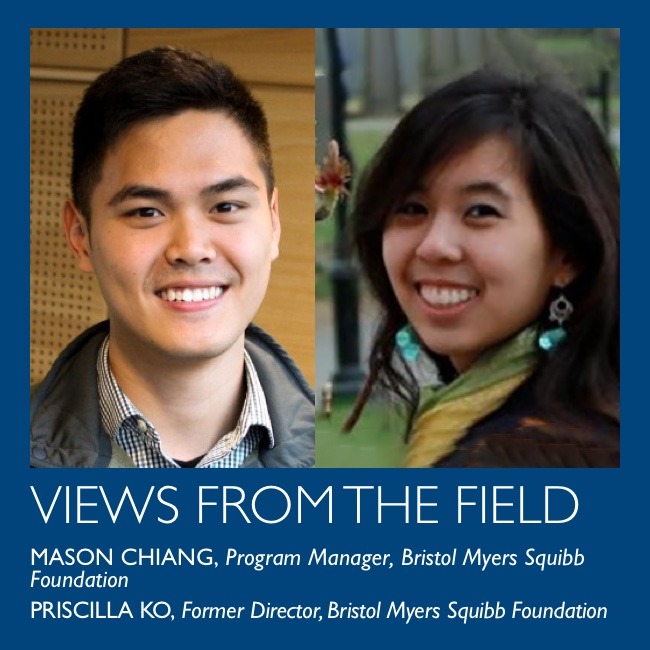Investing in Asian American, Native Hawaiian, and Pacific Islander Communities Through Strategic Philanthropic Partnerships
Published 05-26-22
Submitted by Bristol Myers Squibb Company

Originally published on Grant Makers In Health
By: Mason Chiang, Program Manager, Bristol Myers Squibb Foundation &
Priscilla Ko, Former Director, Bristol Myers Squibb Foundation
May is Asian American Pacific Islander heritage month, celebrating the fastest-growing racial group in the United States. Recent priorities for grantmakers have focused on racial equity, health and well-being, and immigrant rights. Yet, investments for Asian American, Native Hawaiian, and Pacific Islanders (AANHPIs) have been under-resourced and deprioritized, receiving only 0.26 percent of philanthropic dollars and 0.17 percent of research funding from the National Institutes of Health.
Despite limited funding, strong research and evidence show the lack of data disaggregation, cultural stigmatization, and low uptake of primary and preventative care exacerbate the challenge of cancer control in AANHPI communities. Furthermore, each subpopulation has its own unique needs based on linguistic, cultural, and sociodemographic differences, requiring customized interventions to provide cancer support and services across the continuum of care.
The Bristol Myers Squibb (BMS) Foundation’s mission is to promote health equity through outcomes-based interventions using innovative delivery models and community-based supportive services. Through evidence-based literature and discussions with AAPI health advocates, the BMS Foundation issued a Request for Proposal in 2017 to award four 3-year grants totaling $3 million to address cancer disparities and improve cancer care for AANHPIs. Through collaborative efforts, strategic funding, capacity building, and demonstrating sustainable impacts, four BMSF partners offer lessons for the philanthropic community on the importance of investing in AANHPI communities.
In Orange County, California where Asian Americans comprise over 20 percent of the 3.2 million residents, The University of California, Irvine (UCI)’s Advancing Cancer Control Together (ACCT) worked to address the pressing cancer health disparities exacerbated by the lack of a countywide safety net hospital. The project developed a hub-and-spoke model of coordination along the continuum of cancer care for Medicaid beneficiaries. Chinese, Korean, and Vietnamese community health navigators coordinated to increase breast, cervical, and colorectal cancer screening knowledge and access while also working with Orange County’s Medicaid provider, CalOptima, to streamline referrals for cancer diagnoses and treatment. ACCT developed partnerships, documented disparities in late-stage diagnoses of cancers, triaged complex cancer cases to maximize guideline-concordant care, and spearheaded community oncologists’ training. Despite challenges due to the COVID-19 pandemic, ACCT improved ethnic-specific access to primary and specialty care resulting in the screening of over 3,000 participants. To sustain and expand the ACCT project, UCI received $1,300,000 from Office of Minority Health (OMH) to evaluate data equity in Asian Americans, and UCI leadership has invested over $800,000 to expand the catchment of ACCT to increase cancer screenings and follow-up for the Latino patient population.
To increase the quality and quantity of oncological care in primary care, the University of California, Davis (UCD) and Health and Life Organization (HALO) established a new partnership to increase cancer screenings and positively affect cancer control behaviors for Asian Americans. UCD developed a curriculum and provided in-service education to HALO’s bilingual and bicultural medical assistants (MAs). The MAs were demographically similar to HALO patients and enthusiastic to learn and advocate for their communities. Through nine Medical Assistant Academies, topics in cancer prevention and control were taught to the MAs including tobacco cessation, viral hepatitis, colorectal screening, HPV vaccination, cultural competency, and telehealth. These academies resulted in increased knowledge amongst 58 MAs, from a pre-test score of 58.9 percent to 84.0 percent. Furthermore, there was an observed 13.3 percent increase in cancer screenings (20.3 percent increase in mammography, 11.6 percent increase in colorectal cancer screening, and 7.9 percent increase in Pap smears). Building off this investment, UCD was able to secure an additional $1.5 million of federal funding to expand Hepatitis B screening and the permanent hire of an HBV Case Navigator. This funding trained culturally sensitive allied health professionals on cancer education and knowledge through a sustainable community health personnel training program.
For cancer patients, navigation is an effective model for ensuring access to care and adherence to guideline treatments. Trained navigators guide patients through complex health care systems while addressing the social determinants of health that can negatively impact comprehensive cancer care. Unfortunately, many patient navigation programs are human resources intensive, geographically limited, and do not adequately address the unique needs of racial/ethnic or socioeconomic groups.
The University of California San Francisco (UCSF) Patient COUNTS program is an innovative navigation model connecting Asian American patients newly diagnosed with cancer to a patient navigator. Patients receive curated resource recommendations based on a social needs assessment and are connected to a navigator, primarily virtually, via the Patient COUNTS online portal. The program has virtually connected with 50 patients across 3 navigators. Through the Patient COUNTS virtual-navigation platform and infrastructure, the team has received over $2 million in further funding to expand the program into additional population groups and disease outcomes and integrate within existing community- and institutionally based navigation programs to further its reach. This pilot program demonstrates that infrastructure investment and models of care must be responsive to the needs of the patient community inclusive of language, culture, and demographic considerations.
Telehealth technology can greatly reduce cancer health disparities in remote Pacific communities. The University of Hawaii (UH) partnered with Guam, American Samoa, the Commonwealth of the Northern Mariana Islands (CNMI), and the Marshallese Community in Ocean View, Hawai’i Island, to enhance telehealth capacity via strengthening collaboration between the local health system and their respective communities, providing cancer education and case management telehealth didactics, and training community health workers. Infrastructure disparities between the island nations and Pacific communities presented unique challenges. In the State of Hawai’i, the Marshallese faced the greatest disparities with no running water, intermittent electricity through shared household generators, and lack of internet and cell phone connectivity. UH pivoted to facilitate the priority of COVID-19 needs including testing, vaccination, and education. Telehealth infrastructure for CME accredited cancer prevention and control educational and training modules for providers and community health workers were delivered. Despite setbacks with typhoons, conflicting telehealth policies, and the pandemic, over 400 local providers and medical staff attended telehealth training. Each Pacific Island community differed in its respective infrastructure and community readiness for telehealth, requiring constant project flexibility and adaptation. The UH team is working to develop a self-sustaining cancer telehealth system within the next 7-10 years through community, state government, and private philanthropic partnership/support.
Call to Action
These partnerships exemplify the need to invest in AANHPI communities and the ability of community partners and interventions to deliver sustainable and scalable change. It is the collective responsibility of private and public funders to ensure equitable practices, operations, and grantmaking with consideration for AANHPI communities. The BMSF supports the following recommendations from the State of Philanthropy among Asian Americans and Pacific Islanders September 2020 report to increase the representation of AANHPI communities:
- Be inclusive of AANHPI communities. To battle the historical exclusion of AANHPI communities from data collection efforts and research, grantmakers have the opportunity to collect and share data that includes AANPHI. While AANHPIs are often grouped together, the communities are not a monolith and data disaggregation is paramount in identifying disparities in care. Grantmakers should have diversity within the AANHPI umbrella included in their grant review, decisionmaking process, board of directors, and internal organization’s staff workforce. Particularly in geographies with large AANHPI populations, such as California and Hawai’i, Foundations should evaluate their portfolio, projects, and PIs to ensure representation of their constituents.
- Fund AANHPI communities. Evolve grantmaking operations and practices to better support organizations led by and for AANHPI communities including language access in proposal applications, conscientious efforts to support smaller nonprofits in addition to more established organizations, and provision of multiyear funding and general operating support.
- Build intersectional and coalitional power. There is an opportunity to build a progressive coalition of communities advancing racial, social, and economic justice. As we pursue health equity, where all individuals have an equal opportunity to live the healthiest life possible, grantmakers should recognize and amplify the intersectional voices of AANHPI communities and human rights groups such as LGBTQ+ and immigrant communities.
This article was written in collaboration with Principal Investigators: Moon Chen, Scarlett Lin Gomez, Julie Ha Thi Dang, Cevadne Lee, Mavis Nitta, Tung Nguyen, Neal Palafox, and Sora Park Tanjasiri

Bristol Myers Squibb Company
Bristol Myers Squibb Company
Bristol Myers Squibb is a global biopharmaceutical company whose mission is to discover, develop and deliver innovative medicines that help patients prevail over serious diseases. For more information, please visit www.bms.com or follow us on Twitter at http://twitter.com/bmsnews.
More from Bristol Myers Squibb Company

